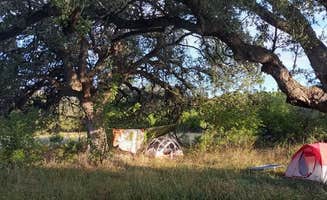Primitive camping opportunities near Bastrop, Texas center around undeveloped sites in natural settings. These rustic camping areas require self-sufficiency and preparation for wilderness conditions. San Gabriel River Trail connects several dispersed camping locations, offering backpackers secluded spots without developed amenities or facilities.
What to do
Explore Lake Georgetown shoreline: Visitors hiking to Sawyer Park Primitive Campsites can set up camp along the water's edge. "We ended up not following our AllTrails after a fork in the road heading towards the campsite, and were pretty pooped so decided to camp there off Sawyer Campsite Rd. People had clearly used the shore as a campsite before as there was a makeshift fire pit and some cleared areas for tents. Water and views were beautiful," reports one camper.
Bring multiple water sources: When backpacking to dispersed sites near Bastrop, pack more water than you think necessary. The combination of Texas heat and limited reliable water access makes hydration critical. A seasoned backpacker advises carrying "at least 2 liters" while hiking, noting that "while you may be hiking within site of Lake Georgetown, it is not always convenient to access the water."
Watch for changing weather patterns: Be prepared for sudden storms when backcountry camping in this region. Locations near water bodies can experience increased humidity during rainfall. One camper at Walnut Springs Primitive Campground described "a very last minute camping trip on a Sunday evening to Monday morning" where they "enjoyed our stay during a thunderstorm under the big trees."
What campers like
Multiple access options: Dispersed campsites offer various entry points for different skill levels and preferences. Walnut Springs can be "biked in from camp Tejas four miles away or can hiking from Russell Park 2 mi away," giving campers flexibility in planning their approach.
Weekday solitude: The rustic camping near Bastrop, Texas provides quiet escapes from crowds, particularly on weekdays. Many primitive sites see minimal traffic Monday through Thursday, making them ideal for solitude seekers. Experienced campers note that "during the weekdays you may not see a single person," though weekend traffic increases with "backpackers and scout troops practicing backpacking."
Natural camping zones: The undeveloped nature of these sites allows for flexible camping arrangements. At Sawyer Park, "there are a few areas with clear land or tent pads where you may camp. But there are also zones where you may simply camp wherever you can setup a tent or hammock," giving visitors freedom to select their ideal spot.
What you should know
Prepare for complete self-sufficiency: Rustic camping in this area requires bringing all necessities. "No amenities; be prepared to dig cat hole, if drinking lake water be prepared to filter and sterilize," warns one visitor. Old facilities that may appear on maps are often unusable, with campers noting "there is an old latrine at this site, but it is in poor shape and no-one really uses it."
Trail difficulty varies seasonally: Summer conditions can make hiking challenging along the 26.2-mile San Gabriel River Trail. The route includes exposed sections with limited shade that can become dangerous in hot weather. Experienced hikers recommend planning carefully for summer trips due to the combination of heat and exposure.
Leave No Trace practices required: With no trash facilities or services, proper wilderness ethics are essential when camping near Bastrop. Pack out all waste, bury human waste in cat holes, and minimize impact on these natural areas. Primitive campgrounds function under strict first-come, first-served policies with no reservation systems.
Tips for camping with families
Choose closer access points: When backpacking with children to dispersed sites, select trailheads with shorter distances. Walnut Springs offers a family-friendly 2-mile hike from Russell Park, making it more accessible for groups with younger campers than the 5-mile routes to other primitive sites.
Plan for rain contingencies: Texas weather can change rapidly, so proper tent setup and rain protection are crucial for family comfort. One family camping trip faced challenges when "rain started pretty heavily (and being close to the water probably didn't help with humidity inside the tent) and our rain fly was unwilling to cooperate so we got a bit wet."
Look for natural features: Primitive sites with natural shade and terrain features provide better family camping experiences. Walnut Springs features a "large open area; four fire pits, four lamp hangers, four picnic tables, trees closer the trail and grassy areas closer to the water," creating natural play spaces and comfort zones for family camping.
Tips from RVers
Park at designated trailheads: RVers accessing backcountry camping should use official parking areas at trailheads. Leave information about your hiking plans visible in your vehicle or notify park administrators about your backcountry camping intentions. "It is good to advise one of the park administers that you will be hiking or place a note inside your car that you are hiking."


